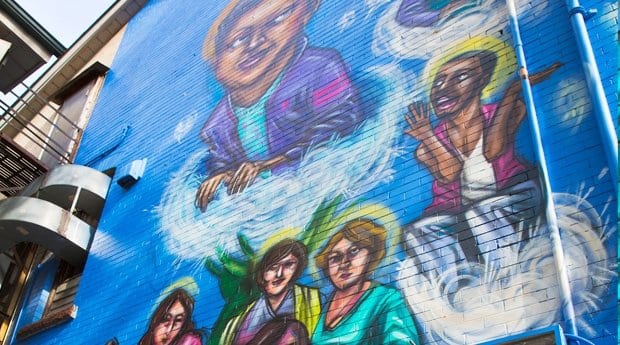
The Dandelions: Queer and Trans* Performers in the Wind, by Nadijah Robinson and Elicser. Credit: Adam Coish
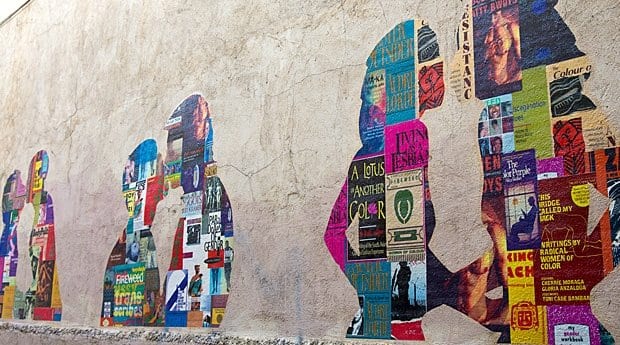
Kiss and Tell, by Natalie Wood. Credit: Adam Coish
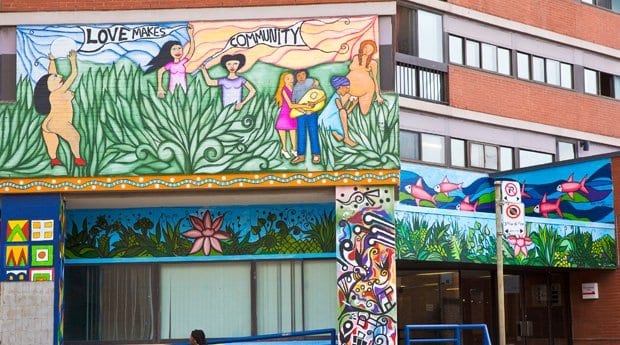
Love Makes Community, by Alex Flores. Credit: Adam Coish
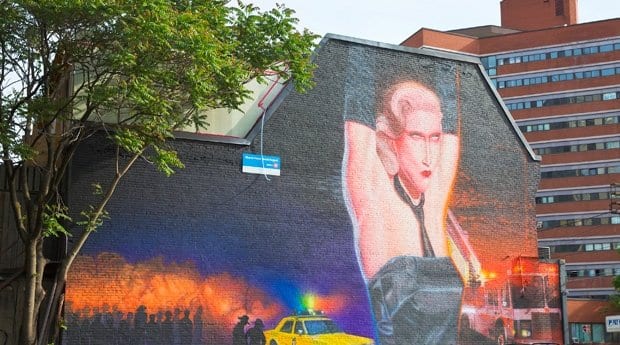
The Bathhouse Raids, by Christiano De Araujo and Troy Brooks. Credit: Adam Coish
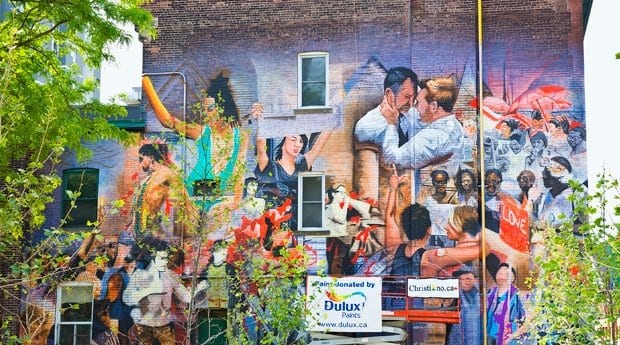
The 519: LGBTQ History & Community, designed by John Kuna, painted by Christiano De Araujo. Credit: Adam Coish
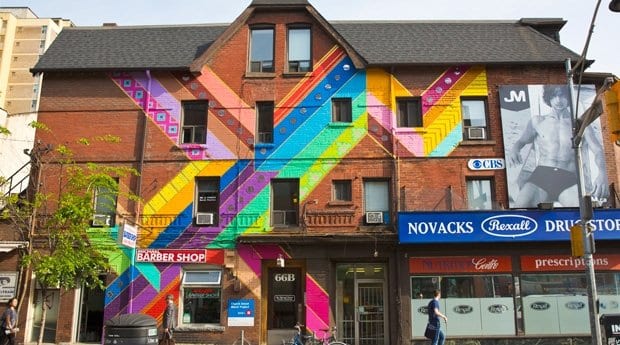
Intersections, by Meera Sethi. Credit: Adam Coish
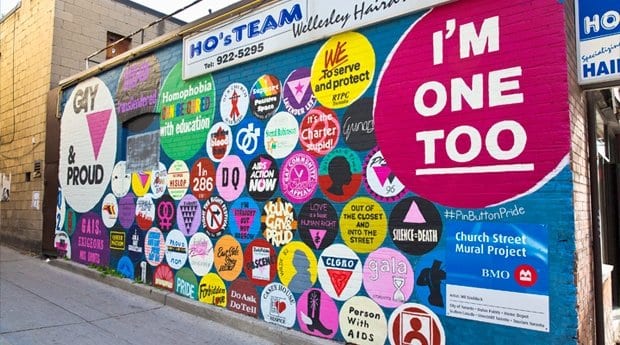
Pin Button Pride, by William Craddock. Credit: Adam Coish
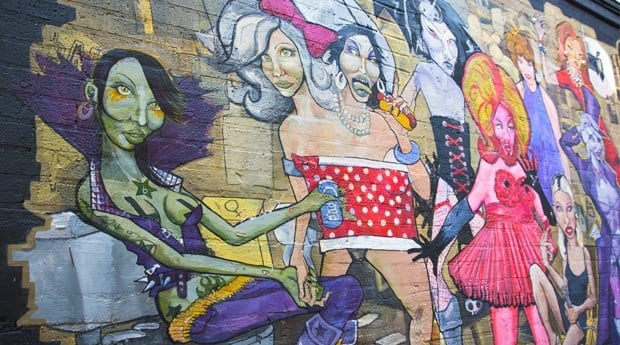
UltraChurch, 50 VIP Party People 1948–2014, by Lily Butter Land. Credit: Adam Coish
At a time when the City of Toronto lacked political leadership and the character of its Church-Wellesley neighbourhood was threatened by an influx of corporate chains and community apathy, Councillor Kristyn Wong-Tam proposed the ambitious Church Street Mural Project.
Wong-Tam used a model of community engagement and consultation that saw government, sponsors, storytellers, community residents and artists work together to bring this vision to life. And now, despite a few bumps along the way, the Church-Wellesley Village has a shiny new facade just in time for WorldPride.
In January 2013, artist and activist Syrus Marcus Ware joined James Fowler as co-curator of artistic submissions and general overseer of the project’s development. Ware helped to organize the early planning meetings, where storytellers associated with the Canadian Lesbian and Gay Archives (CLGA) were invited to highlight some of the founding characters and key incidents of the gaybourhood as potential inspiration to the artists in attendance.
He also helped to sift through all 69 submissions — an enormous number, given the complexity of the application process — some from as far away as Italy and California. “The idea of creating a graphic history of a community and of storytelling,” he said, “combined with large-scale public art — building an entire village of public art — really appealed to people.”
Meera Sethi applied to be part of the project from Australia. Her enormous wall, at the corner of Church and Wellesley, on the building that houses Rexall pharmacy, uses bright colours and reflective mylar to pay homage to the textiles of the nomadic Rabari tribe of India and Pakistan.
“Being able to transform that space into a visual marker of South Asian identity was incredible,” she says. And sure enough, as the first days of winter approached, unbeknownst to her, members of the South Asian community organized at the base of her mural to protest Section 377 of the Indian Penal Code (the recent ruling that made gay sex illegal in India).
Artist Natalie Wood also chose to represent less-told queer stories in her mural, located in a quiet alleyway between two buildings just west of Church and north of Wellesley. Her piece is a collage of images, inspired by New York artist collective Gran Fury’s Kissing Doesn’t Kill poster series from 1989, that depicts the real-life silhouettes of Annette Clough and Krin Zook, who founded the Lavender Conception Conspiracy in 1984.
“I’ve been around for quite some time,” Wood says. “Having came out in the late 1980s, it felt like an honour to find a way to make sure the voices of the people who came out around me were present. People stopped me to say, ‘This brings back memories — I remember when this [book] came out and the conflict and uproar it caused,’ and that’s what I wanted — for people to remember and to see themselves in my work.”
William Craddock’s mural depicting early activist pin buttons is directly sourced from the extensive collection at the CLGA. Already, public response has been overwhelming: “People have been stopping and taking photos with their favourite buttons, which is exactly what I wanted. Everyone is so engaged with the buttons. It’s a great conversation starter, especially with youth who don’t know the origin of the slogans.”
Craddock’s collaboration with the CLGA will continue beyond the completion of his wall — he’s preparing to release an interactive version of his design in the fall, using his website to link buttons in the mural to the originating conflict or event.
Artists Alexa Hatanaka and Patrick Thompson were similarly inspired by the CLGA. “We ended up leafing through many old Body Politic magazines until something jumped out at us,” Hatanaka wrote in an email from her current location in the Arctic. She discovered a half-page, nondescript personal ad that read “Happy 10th Anniversary Joe, From Dave” and based her design on that simple, but significant sentiment. “We took that Body Politic inspiration to be historically significant because, as discussed in the meetings with elders and important figures in the community, non-heterosexual classified ads were not allowed to be published in the mainstream newspapers.”
As Alex Flores was completing her mural, she turned to the residents she saw every day to ask whether they preferred fish or whales in the final product. “They all said fish,” she said. “So I switched my design to incorporate what they wanted. I was very impressed by these women. The very first day, I had a confrontation with a resident who said, ‘You can’t put gays and lesbians on my building!’ but we soon started talking every day — I’m a very happy painter — and now she’s my friend. I’m going to miss her.”
Christiano De Araujo, the only person charged with executing two murals, felt similarly embraced by the community. “I thought I would be discriminated against because I was not gay or no one would accept me,” he says, “but I learned that it’s not like that; we are all one. I learned that Pride and the Village are not only for gay people. It was a great experience.”
De Araujo’s first mural, co-designed by Troy Brooks, took form on the enormous southern wall of a building at Church and Granby streets, the old Barn location. It depicts the uprising of community members against the police bathhouse raids, alongside a statuesque Madonna-like woman overseeing the drama. The second mural, designed by John Kuna, is on the north side of the 519 Church Street Community Centre and highlights milestones in the queer liberation movement, with photorealistic portrayals of two-spirit First Nations Pride celebrations, ratification of gay marriage law in Toronto and even the famous “steps” at the original Second Cup location, which was a popular cruising hangout.
Wong-Tam couldn’t be more pleased with the result of years of hard work. “The stories of the Church and Wellesley neighbourhood go beyond architecture. The community connection is cultural, belonging to every one of us in the LGBTQ2-spirited community and beyond. Seeing these murals fosters a soulful, political and cultural connection to the Village.”
According to the paint sponsor, Dulux, the murals will last at least 25 years. Wong-Tam isn’t the only one excited to imagine where the community will be a quarter century from now.
“It’s exciting to think that the murals will outlast the storytellers, creating a visual archive of what’s happened here and will continue to do so for the next while,” Ware says. “When I walk around other cities, I see the old-timey murals — now just shadows of paint — and they’re a window into a moment of time.”
Mural Project List
Love Makes Community
Alex Flores
89 Church St, north wall
Homage
Tristan Whiston and Anna Camilleri (Red Dress Productions)
Associate artists: Katie Yealland and Chantelle Gobeil
399 Church St, south wall
The Bathhouse Raids
Christiano De Araujo and Troy Brooks
418 Church St, south wall
The Dandelions: Queer and Trans* Performers in the Wind
Nadijah Robinson and Elicser
508 Church St, east and south walls
Lupus Inter Homo
Rocky Lawrence Green
518 Church St, panels to be installed on second floor
Intersections
Meera Sethi
552 Church St, south wall
Platinum China Anniversary
Patrick Thompson and Alexa Hatanaka
552 Church St, north wall
Kiss and Tell
Natalie Wood
66 Wellesley St E, alleyway, west side, nearest road
UltraChurch, 50 VIP Party People 1948–2014
Lily Butter Land
66 Wellesley St E, alleyway, west side, furthest from road
Pin Button Pride
William Craddock
66A Wellesley St E, alleyway, east side, nearest road
The 519: LGBTQ History & Community
Designer: John Kuna
Painter: Christiano De Araujo
519 Church St, north wall
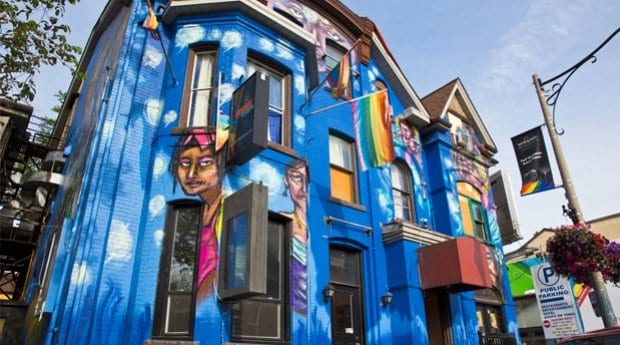
 Why you can trust Xtra
Why you can trust Xtra


